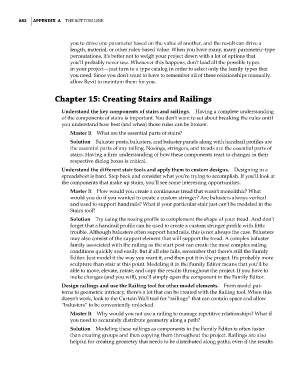Page 916 - Divyank Tyagi
P. 916
882 | AppendIx A The BoTTom Line
you to drive one parameter based on the value of another, and the result can drive a
length, material, or other rules-based value. When you have many, many parametric-type
permutations, it’s better not to weigh your project down with a lot of options that
you’ll probably never use. Whenever this happens, don’t load all the possible types
in your project—just turn to a type catalog in order to select only the family types that
you need. Since you don’t want to have to remember all of these relationships manually,
allow Revit to maintain them for you.
Chapter 15: Creating Stairs and Railings
Understand the key components of stairs and railings. Having a complete understanding
of the components of stairs is important. You don’t want to set about breaking the rules until
you understand how best (and when) those rules can be broken.
Master It What are the essential parts of stairs?
Solution Baluster posts, balusters, and baluster panels along with handrail profiles are
the essential parts of any railing. Nosings, stringers, and treads are the essential parts of
stairs. Having a firm understanding of how these components react to changes in their
respective dialog boxes is critical.
Understand the different stair tools and apply them to custom designs. Designing in a
spreadsheet is hard. Step back and consider what you’re trying to accomplish. If you’ll look at
the components that make up stairs, you’ll see some interesting opportunities.
Master It How would you create a continuous tread that wasn’t monolithic? What
would you do if you wanted to create a custom stringer? Are balusters always vertical
and used to support handrails? What if your particular stair just can’t be modeled in the
Stairs tool?
Solution Try using the nosing profile to complement the shape of your tread. And don’t
forget that a handrail profile can be used to create a custom stringer profile with little
trouble. Although balusters often support handrails, this is not always the case. Balusters
may also consist of the support element that will support the tread. A complex baluster
family associated with the railing as the start post can create the most complex railing
conditions quickly and easily. But if all else fails, remember that there’s still the Family
Editor. Just model it the way you want it, and then put it in the project. It’s probably more
sculpture than stair at this point. Modeling it in the Family Editor means that you’ll be
able to move, elevate, rotate, and copy the results throughout the project. If you have to
make changes (and you will), you’ll simply open the component in the Family Editor.
Design railings and use the Railing tool for other model elements. From model pat-
terns to geometric intricacy, there’s a lot that can be created with the Railing tool. When this
doesn’t work, look to the Curtain Wall tool for “railings” that can contain space and allow
“balusters” to be conveniently unlocked.
Master It Why would you not use a railing to manage repetitive relationships? What if
you need to accurately distribute geometry along a path?
Solution Modeling these railings as components in the Family Editor is often faster
than creating groups and then copying them throughout the project. Railings are also
helpful for creating geometry that needs to be distributed along paths, even if the results
bapp01.indd 882 5/3/2014 12:11:32 PM

